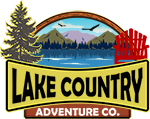WATERCRAFT SAFETY
SAFETY STARTS WITH YOU!
A day on the lake is a lot of fun for family and friends and great memories for years to come. Whether it be fishing, water skiing, jet skiing or pleasure cruising the lake brings a calming connection to nature and complete relaxation.
Activities on and in the water can be fun and safe as long as we take precautions, are vigilant, are sober and alert and respectful of other boaters, property owners and our passengers.
At Lake Country Adventure Co. Rentals we want you to have a good time but more importantly we want you and your loved ones to be safe. With that in mind we recommend that all operators obtain their pleasure craft operator’s card through an accredited training provider. We have provided two links to two different providers.
We strongly recommend that you take the course if you don’t have one or if you feel you need a refresher. This is a more comprehensive course than was introduced years ago and there is real value in the information and process in protecting you and your family.
https://www.boat-ed.com/canada/
For those who do not have an approved Canadian Pleasure Craft Operator Card, there will be on site instruction and review of safety, rules and operation of the watercraft.
We also recommend for renters of PWC that they review the instructional video from Sea-Doo prior to your rental period. https://www.youtube.com/watch?v=dJMGdjjGwtY&t=83s
